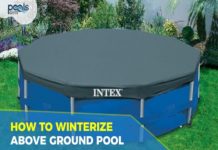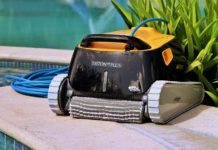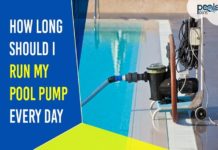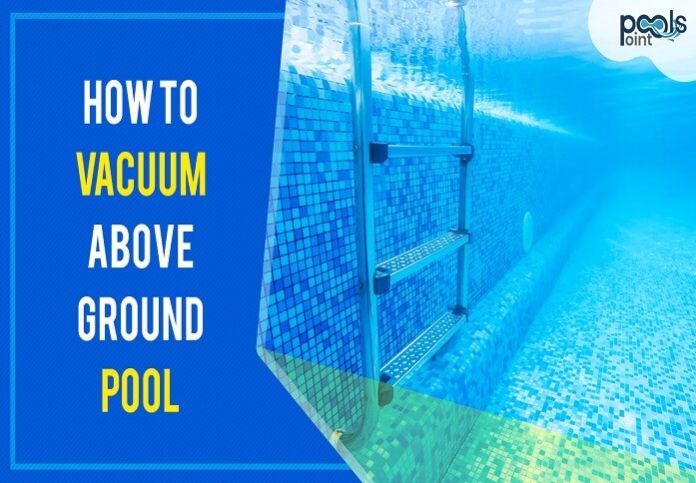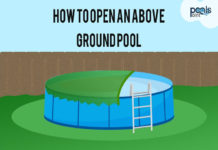Are you excited about taking a dip in your above ground pool? These swimming pools can provide your household with many benefits.
They’re cheaper, easier to install, and more mobile than in ground pools. However, it’s important to provide effective care and maintenance including how to vacuum above ground pool.
Whether you’re opening your pool or doing routine cleaning it’s critical to keep the water as clean and safe as possible. On-ground pools require less maintenance than underground pools.
However, you’ll still have to take steps like regularly vacuuming your swimming pool. This helps to prevent microbes and other nasty stuff from building up on the walls and floor of the pool.
Table of Contents
When and Why to Vacuum Pool
Before discussing how to vacuum above ground pool it’s important to know why it’s important and how often you should do this routine maintenance.
You should vacuum the pool when it’s dirty to keep the water clean, right? Yes, but it’s a little more complicated than that.
Reasons to Vacuum Pool
There are various reasons you should be vacuuming your pool regularly.
1. Circulates water
One of the main reasons is to circulate water throughout the pool. Factors like the sun, rain, and air can affect the pool’s acidity/basicity and chlorine levels.
You can bring chemical balance back by combining the water on the bottom and top of the pool. This provides better water balance and chemical use that’s more efficient. These are both important steps to take.
2. Problem prevention
Vacuuming your on-ground pool can help to prevent various problems. They include algae blooms, unpleasant odors, and liner tears.
Not only can these become problems but also require time, effort, and money to fix. That reduces your swim time! Simply vacuuming your pool on a regular basis can help to prevent many problems in the long-term.
1. Circulates water
One of the main reasons is to circulate water throughout the pool. Factors like the sun, rain, and air can affect the pool’s acidity/basicity and chlorine levels.
You can bring chemical balance back by combining the water on the bottom and top of the pool. This provides better water balance and chemical use that’s more efficient. These are both important steps to take.
2. Problem prevention
Vacuuming your on-ground pool can help to prevent various problems. They include algae blooms, unpleasant odors, and liner tears.
Not only can these become problems but also require time, effort, and money to fix. That reduces your swim time! Simply vacuuming your pool on a regular basis can help to prevent many problems in the long-term.
3. Investment protection
An above ground pool probably won’t be the biggest purchase you’ll make in your life. That said, most units aren’t “cheap.” By doing routine maintenance you can protect your investment and deal with issues like debris including twigs, leaves, bugs, and chemicals
that get into your pool.
Ultimately taking care of your pool will instill pride of ownership. When you’ve maintained your pool effectively it will help you enjoy the unit even more when you take a dip on a hot and humid summer day.
When to Vacuum Pool
So it’s clear that vacuuming your pool is important to protect your investment and provide swimmers with a better/safer experience.
The next big issue is: when should you vacuum your pool? One sign that it’s time to vacuum the pool is when the water becomes cloudy. If that occurs then it’s time to vacuum the on-ground pool and do it as soon as possible.
The reason is certain contaminants based on their volume sink to the bottom of the pool. You’ll need a vacuum to rid your pool of them. Make sure to consider your need and preferences to pick the best pool vacuum to handle the cleaning.
Prep Step: Collect Supplies Needed
Prior to reviewing the steps for how to vacuum above ground pool it’s critical to gather the materials you’ll need. This will make the whole process smoother since you’ll have all the equipment/tools required to get the job done.
Here are some must-have tools for vacuuming your above-ground door.
Telescoping Pole
When cleaning/vacuuming your on-ground pool make sure to select a quality telescoping pole. The unit should be durable and made of materials like aluminum. This will help to extend the lifespan of the unit.
Another key issue is the length of the pole. Look for ones that will allow you to clean your pool efficiently regardless of the size. For example, you can find poles with a range up to 20+ feet.
Make sure the length is long enough to cover the pool’s radius so it will reach to the center of the pool.
If you have multiple pools the pole should be long enough for the largest unit. You can find many units in the under-$50 range so it’s worth spending more for a quality telescopic pole.
No products found.
Pool Vacuum
A quality vacuum is needed to get the job done right. These vacuums can be used for other items including spas, hot tubs, Jacuzzis, and even fountains.
What should you look for?
One of the key features is the amount of power the vacuum produces. It should have enough juice to draw debris like leaves into the collection bag. So when picking a vacuum make sure it’s powerful enough for your swimming pool’s size.
Then there’s various features to consider. For example, is the telescopic pole included? Is the vacuum a mini or full-size unit? How complex is the vacuum’s design and operation? These are all big questions to ask when picking a vacuum model to make sure you’re choosing wisely.
No products found.
Vacuum Head
When vacuuming your on-ground pool it’s important to have the various accessories you need to get the job done. That includes the head for the pool vacuum. The vacuum pole/head are dropped into the pool.
Two types of vacuum heads are available. The one you should look for has brushes rather than wheels. The one for wheels is for concrete in-ground swimming pools.
No products found.
Net Skimmer
Here’s another must-have item when vacuuming/cleaning your above-ground pool. This is great for removing items like leaves and bugs floating on the surface of your pool.
There’s the old saying that the “cream rises to the top.” It’s also where unwanted debris floats in your above-ground pool so it’s critical to invest in a quality pool skimmer.
What should you look for? Make sure the unit is made of water-proof materials so you won’t have to worry about rust/corrosion. You should also pick a skimmer net that can be used in any pool
regardless of the flow of water.
No products found.
Vacuum Hose
This is a must-have accessory to secure when preparing to vacuum your above-ground pool. The hose is needed to vacuum debris from the walls/floor of the swimming pool.
You must connect the vacuum to the vacuum head/telescoping pole. Then lower the hose into the swimming pool, fill it with water, and plug the end into vacuum line or skimmer suction.
The debris is then pulled into a filter pump basket through the vacuum hose. After vacuuming the basket must be cleaned and the filter backwashed.
No products found.
Pool Brush
This cleaning tool isn’t technically used for learning how to vacuum above ground pool but is still a critical component for cleaning the walls and floor.
When selecting a brush make sure to pick one that’s right for your pool’s material. Avoid brushes for concrete in-ground pools.
Look for a sturdy brush with strong bristles and ergonomic handle. The brush is ideal for brushing algae and other debris off the pool’s walls/floors.
It’s another item that typically doesn’t have a sky-high price tag so you should consider buying a quality brush so you won’t have to replace it each season.
No products found.
Selecting the Right Pool Vacuum
When picking a pool vacuum there are many models to pick from. Since this is the main instrument needed for the process it’s critical to choose wisely.
Here are some of the main types to pick from:
1. Suction Side Cleaners
This variety of above ground pool cleaners is classified as an “automatic” unit. The cleaner is connected to a skimmer box. It teams up with the pool’s filtration system to suck all debris.
This type of pool cleaner provides some noteworthy benefits. The installation/maintenance is quite simple. It’s also a good option for small/medium sized pools. Suction side cleaners are also budget-friendly so if you’re on a shoestring budget this might be the best option for you.
You can pick from two types of suction side cleaners:
Geared Suction Cleaner
It follows the pattern that’s pre-set and is a good option to clean the pools’ surface in the shortest time possible. This is a good option for small pools and can also get to tight
corners.
Inertia Suction Cleaner
This is an undirected kind of cleaner. If your pool doesn’t have sharp corners then this is a good option. So if your swimming pool has curved wall then this is definitely a good option.
2. Pressure Side Cleaners
This is an advanced kind of vacuum cleaner for above-ground pool. It’s super-powerful. This is used to drive the cleaner, absorb debris, then send it to the unit’s filter bag.
A filter bag is bundled with the vacuum, which makes the process much easier. You can use this type of vacuum for small/medium size pools. The machine is very powerful so you’ll have to do less vacuuming than with other types of units.
A pressure side cleaner provides several benefits. It’s powerful so it picks up more debris in less time. The built-in bag means less stress on the pool’s built-in filter. The vacuum is also easy to use since the holes prevent tangles.
3. Robotic Pool Cleaners
These units are very expensive but a bit expensive. They’re bundled with an internal pump and built-in filtration system. This takes stress off the pool’s current filtration system.
It also lowers the cost/time required to clean your on-ground swimming pool.
These vacuums provide some major benefits. They’re good for large pools. They also require less time/effort for the pool owner so if those are issues for you this type of vacuum is a good option.
The robotic pool cleaners are effective, efficient, and put less stress on your pool’s built-in filtration system.
Pool Brush
This cleaning tool isn’t technically used for learning how to vacuum above ground pool but is still a critical component for cleaning the walls and floor. When selecting a brush make sure to pick one that’s right for your pool’s material. Avoid brushes for concrete in-ground pools.
Look for a sturdy brush with strong bristles and ergonomic handle. The brush is ideal for brushing algae and other debris off the pool’s walls/floors. It’s another item that typically doesn’t have a sky-high price tag so you should consider buying a quality brush so you won’t have to replace it each season.
Methods for Vacuuming Above Ground Pool
The process of learning how to vacuum above ground pool involves two main methods. You should know them whether you’ve just installed a brand new above-ground pool or are required to
do it for someone else.
The two main methods are the manual and automatic method of cleaning the pool. The automatic method is faster and less strenuous. So if you want to clean your pool without spending
lots of time and effort then a robotic vacuum is a good option.
This convenience doesn’t come without a price—literally. So while an automatic vacuum is more convenient it also boosts the price of the unit.
These robotic pool cleaners can clean the entire pool. That includes the walls, cove, and floor. The result is a hands-free cleaning of your above-ground pool.
Then there’s the manual vacuuming system. This involves the vacuum head with rollers/brushes, big plastic hose, and long metal/fiberglass pole. Since the vacuum is manual it means you’ll have to roll up your sleeves to clean the interior of the swimming pool.
On the other hand, this can also provide some benefits. The costs are lower so you won’t have to spend big bucks to vacuum the pool. You can also get in a good workout so if you want to lose some weight this is one of the best options when you’re working on your pool.
An X-factor is when learning how to vacuum above ground pool a manual vacuum can help create pride of ownership.
You’ll likely enjoy swimming in the pool better when you know it was your elbow grease that helped to clean the walls and floor of debris.
Here are the various steps to manually vacuum your above-ground swimming pool:
Step 1: Remove Big Debris from Surface
1. Use a pool rake/skimmer to remove all the debris on the surface of the pool.
This includes leaves, twigs, bugs, and other big debris you can see floating on the top of the pool.
If you use a skimmer make sure to clean it out once the basket fills up with debris.
2. Use a lightweight/cordless pool vacuum for more convenience You can find many units at online retailers like Amazon.
This type of unit will make the process faster and easier. Such vacuums are bundled with rechargeable batteries and filters.
The main benefits are you’ll be able to clean the pool’s surface in less time.
However, it’s another tool that will add to the total cost of vacuuming/cleaning your pool.
So if you’re on a tight budget for pool care/maintenance you might want to go with a standard pool rake/skimmer or even an old-school leaf rake.
This tool makes the process easier since you can quickly pick up debris like leaves, sand, and algae that are sitting at the bottom of the pool.
3. Turn on pump, take this step after you’ve removed debris on the surface of the above-ground pool. Make sure water is flowing through the filter of the swimming pool.
Step 2: Insert Vacuum Head Into Swimming Pool
Here’s the next step in the process of how to vacuum above ground pool.
- Attach vacuum head to the hose’s swivel end. This is a critical step before you insert the pool vacuum’s head into the water.
- Affix the head to metal/fiberglass pole.
- Lower pole/hose to bottom of pool. Make sure the water return outlet can easily be reached by the telescopic pole.
- Fill hose with H2O.
(Do this by holding the free end in front of water return outlet. Use one hand to hold the pole firmly to make sure it doesn’t float back to the pool’s surface while air is released from the vacuum’s hose. Keep filling up the hose with water until no bubbles are emitted
from vacuum head in the swimming pool)
Step 3:Vacuum Bottom of Pool
1. Slip skimmer disc into skimmer. You might be required to plug the
hose end into suction port.
If that’s the case be certain to pull out hose end out of the pool’s water to fix skimmer disc as quickly as possible. In the process make sure not to let any air into hose.
2. Slowly move head back and forth over the bottom of pool. Do this from a position where you can clearly see the bottom of your pool. Be certain to overlap the previous path each time you pass the vacuum head over the bottom surface of the pool.
3. Vacuum until the whole floor is totally clean.
4. Use a 3-brush vacuum head for more thorough cleaning. This is an efficient way to loosen tough debris on the sides and bottom of the swimming pool.
These units are designed to reach nooks and crannies more easily. You can also use this type of unit for cleaning your pool’s steps.
Step 4: Do Post-vacuuming tasks
Part of learning how to vacuum above ground pool includes post-vacuuming steps:
- Remove vacuum head from telescoping pole.
- Drain H2O still remaining in the vacuum hose.
- Attach cleaning brush to pole Scrub any dirt, debris, or algae on the sides of the swimming pool.
- Clear debris in pump’s strainer basket.
- Do final backwashing for multi-port system and ‘filter’ setting.
- Switch valve back from ‘waste’ to ‘filter’ (if necessary)
- Add fresh water to return old water level (Keep adding water. until you’ve restored the old level)
- Test pool water, make any necessary tweaks to pH, chlorine, and alkalinity.
- Use fresh water to rinse all equipment Return the equipment to your pool’s storage. This will help to prevent extra wear/corrosion and keep it in good working condition.
Step 5: Test Water Using Kit
This is another key step to take when learning about how to vacuum above ground pool. Besides vacuuming and brushing your pool this is one of the most important steps to take to maintain a safe pool.
Here are the general steps to follow although they’ll differ for different kits:
1. Buy a pool test kit
You can find several kits at online retailers like Amazon. Make sure to make sure the kit is complete so you can do all the necessary tests like the H2O’s acidity/acidity, alkaline, chlorine, etc.
These kits provide some perks. They’re usually easy to use so don’t worry if you didn’t ace your high school Chemistry class. The kits are also very affordable so it’s advisable to spend a little more money for a good quality kit.
These kits test many things like:
- pH
- chlorine
- alkalinity
- bromine
- acid
2. Learn how to secure results
Different kits offer different methods for getting analyses. They include the maker’s website, online calculator, or mobile app. Sometimes you’ll have to take the kit o your friendly neighborhood pool supply store.
3. Dip tester into swimming pool
You’ll need to collect water from a minimum depth. Make sure you get a large enough sample (e.g. “fill” line).
4. Test chlorine
This includes free chlorine/chlorine residual.
5. Test pH levels
6. Test acid demand
7. Test total alkalinity
8. Rinse/dry vials
Make sure to follow the specific directions for the particular pool test kit you use. This will help to make sure the results you get are as accurate as possible.
The various kits on the market have many similarities but have different functionalities based on the design and manufacturer.
CONCLUSION
We’ve just reviewed the steps to take to vacuum your above ground pool effectively. It might be part of opening your pool or due to the water looking cloudy in the middle of the summer season.
The key is to vacuum/clean the pool periodically to keep it as safe and functional as possible.
You can also get all the equipment/materials you need like manual vacuums at Amazon. In learning how to vacuum above ground pool the first step is having the right tools for the right job. It gives you a clean start!

